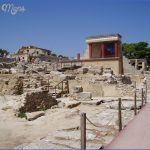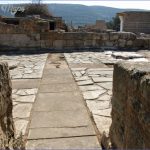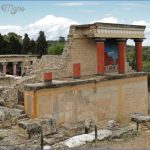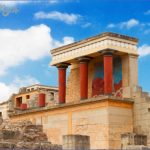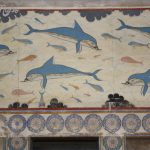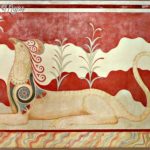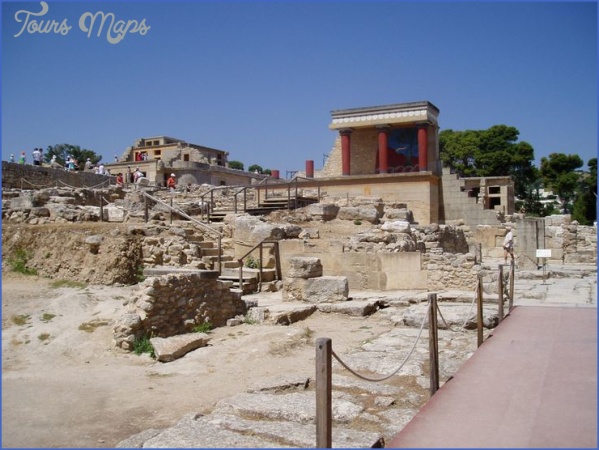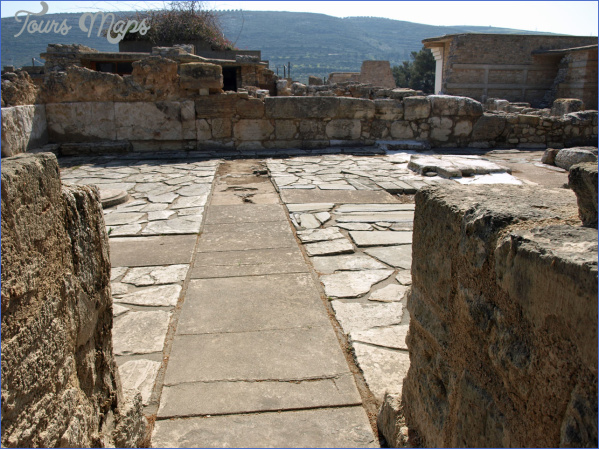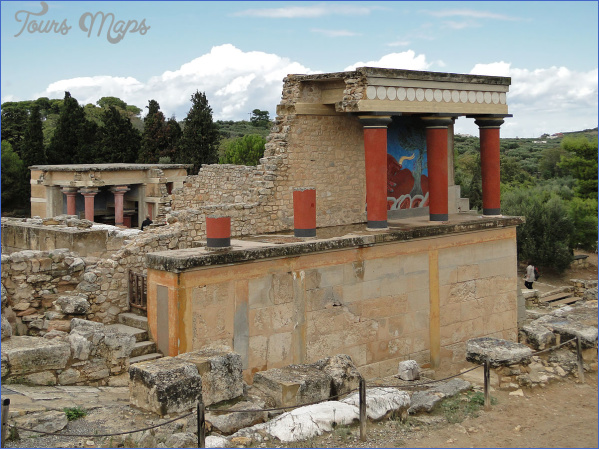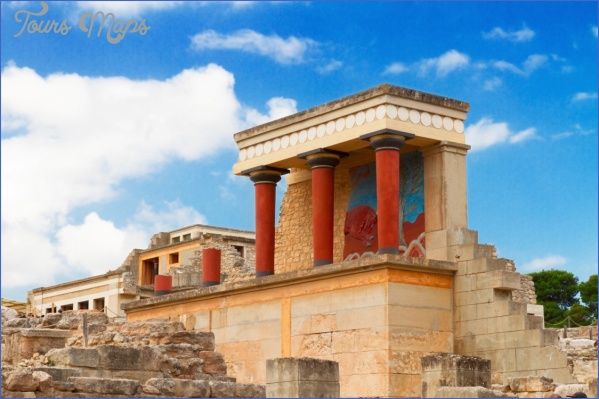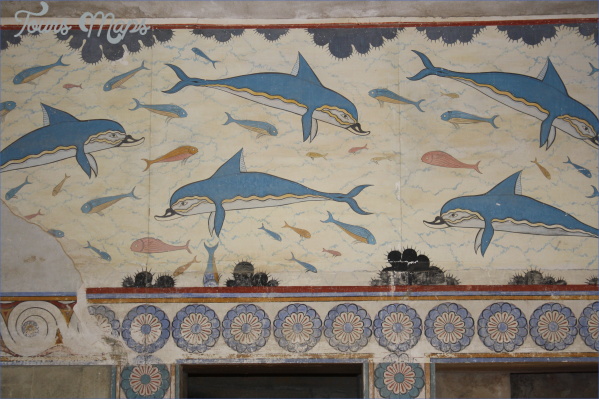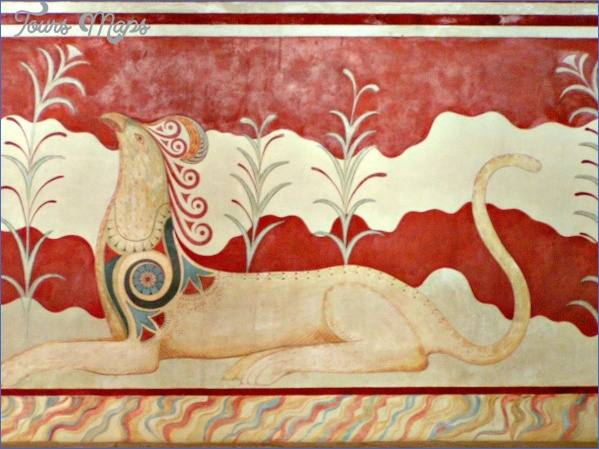Archaeology confirms Knossos’ wealth – though interpretation of much of the accumulated evidence is problematic. By around 1400 bc the palace complex at Knossos was probably the largest and richest in the Aegean, the centre of a Cretan (or ‘Minoan’) empire. Art and traded artifacts show that its influence extended throughout the south Aegean and Near East (a Minoan interpreter may have been employed at Ugarit in Syria in the early eighteenth century bc), west to Sicily and north perhaps as far as Samothrace. There was also considerable contact with Egypt: Egyptian motifs appear in Cretan art; fifteenth-century bc Egyptian tomb paintings from the reigns of Hatshepsut and Thutmose III show Cretans bringing gifts to the Pharaoh; and a fresco at Avaris in the Nile Delta appears to show Cretan bull-leaping.
Knossos in History & Today Photo Gallery
Surrounded by a city of an estimated 8,000 inhabitants, Knossos boasted an efficient civil service. Linear A and B tablets reveal that administrators were interested in everything from the allocation of labour to the revenue from wool. Although weapons have been discovered, mostly associated with burials, there is little evidence for a strong Cretan military. Knossos lacks any apparent fortifications in stark contrast to mainland Mycenae, which probably overran Crete in the fourteenth century bc, destroying other palace sites but preserving Knossos, which survived until the early thirteenth century bc. It was once believed that the eruption of Santorini (Thera), 150 km (93 miles) to the north, brought down Minoan civilization, causing a tsunami and polluting the soil with ash. But the eruption is now confidently dated to the late seventeenth century BC, and some modern scholars suggest that climate change was a factor in Crete’s demise.
Epic and lyric poetry tells of Minoan Crete, but the first historical references (albeit based on legend rather than hard evidence) come from the late fifth century BC. According to Herodotus, Minos was the first king to build a navy. Thucydides agreed, writing of how Minos established a sea-empire, ruling the Cyclades and sending his sons to found colonies. However, apart from a few fragments, we have no full record of the story of Minos, the Minotaur or Daedalus until the Roman period.
The Minotaur’s popularity in Greek art owed much to the rise of Theseus as a major Athenian hero in the early fifth century bc. Scenes from his myth adorned his temple’s walls in Athens, while tradition told that the sacred ship that made an annual pilgrimage to Delos was the very vessel in which Theseus sailed to Crete. Its need for constant overhaul prompted philosophical debate: since every timber had been replaced over time, when did it cease to be the original?
Questions of originality plague Knossos, too. In the early twentieth century the British archaeologist Sir Arthur Evans recreated many of its buildings (in concrete) and reconstructed the frescoes and reliefs which once adorned their walls. For some this represents an act of vandalism. For others it provides a useful template for how Knossos and other Cretan palaces would have looked, with their labyrinthine complexes of buildings – administrative, commercial and residential, including some three storeys high – arranged around wide central courtyards.
Palace life remains largely a mystery. Frescoes, showing segregated men and women watching from steps and balconies, suggest open-air festivals held in both courtyards and ‘theatral’ areas -perhaps similar to the dancing floor Daedalus built for Ariadne. Others (as well as fragmentary sculptures) depict bull-leaping, perhaps the inspiration for the myth of the Minotaur. The location and purpose of bull-leaping are unknown. It may have formed part of a religious ceremony. Miniature clay model bulls were dedicated at cult centres, and many buildings were adorned with ‘horns of consecration’, stylized bulls’ horns, perhaps representing crescent moons, and possibly linked to the Egyptian hieroglyph for ‘horizon’. The horns may also have been associated with the double-axe, or labrys (the origin of the early-Greek word labyrinth, ‘place of the double-axe’). Small models of this axe were frequent ritual offerings; larger versions apparently adorned sanctuaries as totemic objects.
Caves (such as those on Mount Dicte and Mount Ida) and mountain peaks (such as Mount Juktas, clearly visible from Knossos) were important to Minoan religion – all Cretan palaces are in sight of such a cave or peak. Crete may have been a matriarchal society, whose supreme deity Linear B tablets call Potnia (‘Mistress’). One even lists an offering of honey to ‘Daburinthoio Potniai’, perhaps ‘The Mistress of the Labyrinth’. If so, it is the earliest reference to the labyrinth – though we can only conjecture what the word means in this context. Mazes appear in Cretan (and Egyptian) art, but there is no formal labyrinth at Knossos.
A mile south of Herakleion, Knossos is easily accessible by car or public transport. A shaded path leads from the kiosk past three kouloures (possibly storage pits) to the West Court. A walkway runs round the south side of the palace to the South Propylaion. The Central Court is flanked on the east by a building complex housing a tripartite shrine and Throne Room. A monumental staircase leads to an upper level (with a view of adjacent storage rooms and Mount Juktas) giving access to the reconstructed light well above the Throne Room. The ceremonial Grand Staircase is across the Central Court to the east.
The North Entrance Passage leads to the North Pillar Hall. A path runs left past the North Lustral Basin to the Theatral Area, a small stepped courtyard, the terminus of the Royal Road. A path right from the North Pillar Hall leads to the industrial quarter, housing kilns and workshops, and the Queen’s Megaron with the House of the Chancel Screen beyond. A track, affording a dramatic view up to the Horns of Consecration, leads to the right past pine trees in which peacocks roost to the South House, before returning to the West Court and site entrance.
Finds from Knossos and other sites are displayed in Herakleion’s Archaeological Museum. These include original (but heavily restored) frescoes and painted reliefs as well as a cornucopia of artifacts: larnakes (burial caskets), labrys-axes (double-axes), clay models of human devotees and clay and metal bulls. Other highlights include a stone bull’s head rhyton (drinking vessel) with horns of gold, a gaming board decorated with silver and gold leaf and inlaid with rock crystal and lapis lazuli, the Phaistos Disk (a small circular clay tablet stamped with symbols in a spiral) and two small figurines of snake goddesses. (Both disk and snake goddesses are suspected by some of being forgeries from the early twentieth century AD.) There is also a useful model of Knossos in its heyday and an impressive collection of later sculpture, including a seventh-century BC frieze from Temple A at Prinias.
Knossos’ ‘sister’ sites at Phaistos and Aghia Triadha in the south of Crete repay a visit, as does Roman Gortyn, where a descendant of Zeus’ evergreen plane-tree can be admired. Closer to Knossos, Mount Juktas affords superb views (including of Knossos itself).
Maybe You Like Them Too
- Theseus & Peirithous
- The Voyage of the Argo Begins
- Minos, his Loves & his Family
- The Centaurs
- Athens in History & Today

